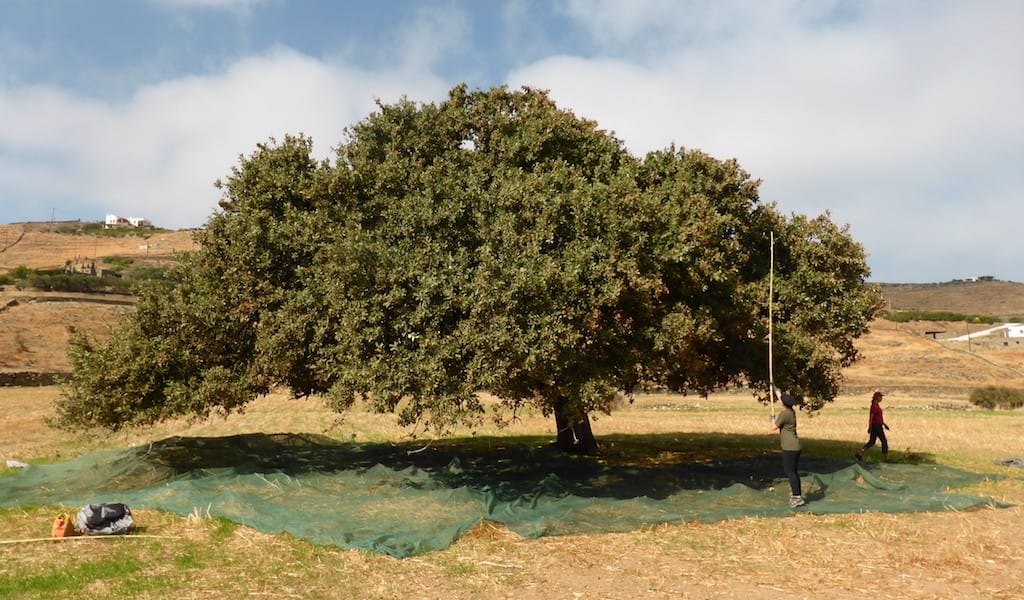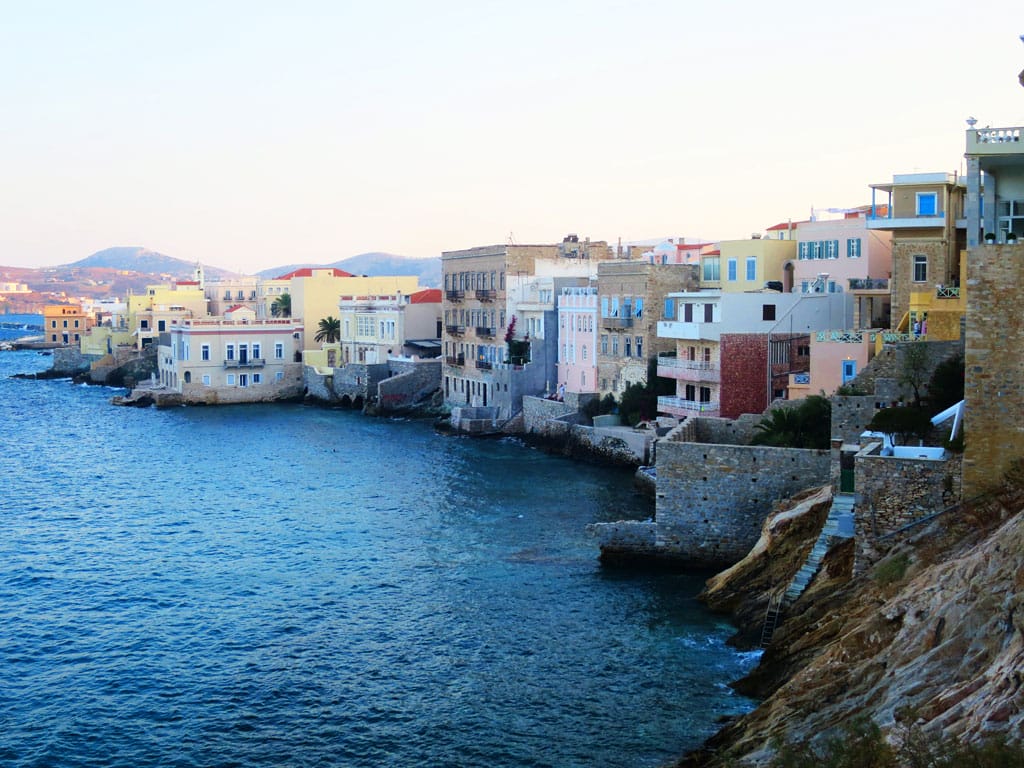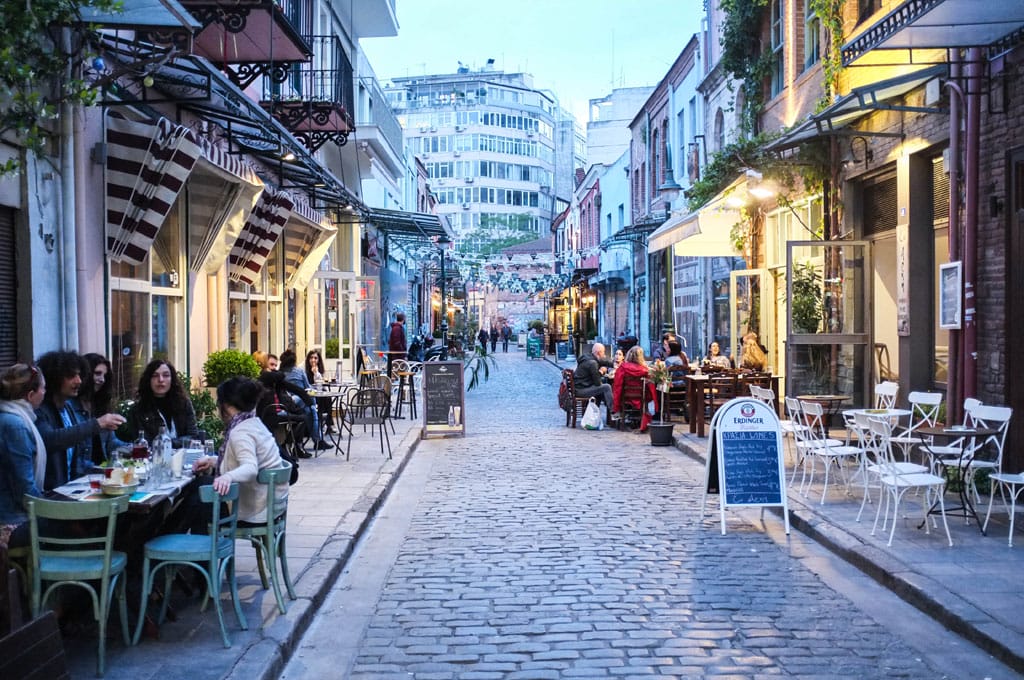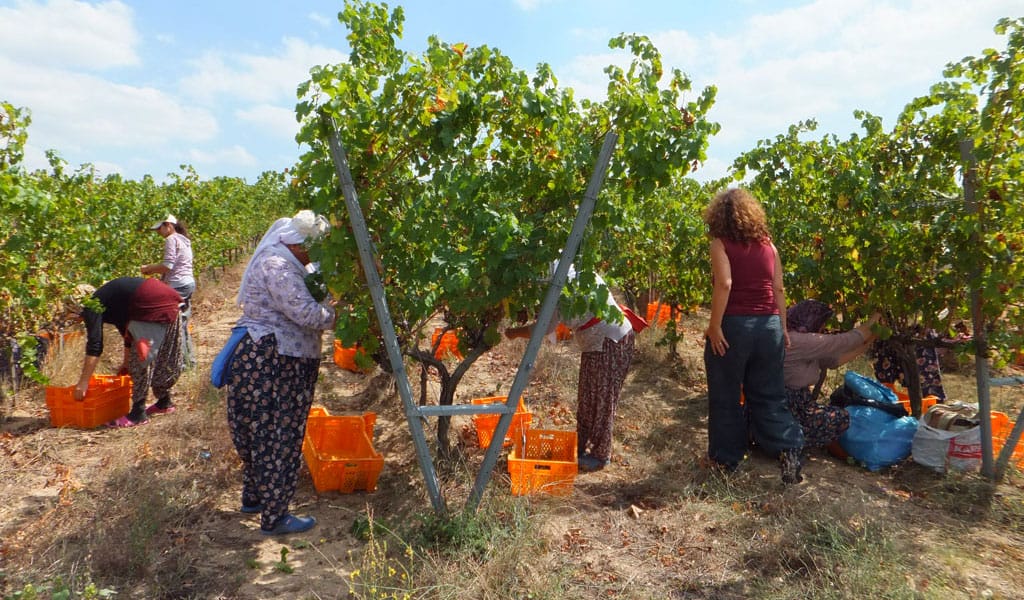When we embarked on the ferryboat to the South Aegean island of Kea at Lavrio, about an hour’s drive from Athens, we didn’t see any of the tourists that typically fill ferries going to the Cyclades in summer. Traveling with the summer winds just an hour further, we seemed to slip through an invisible door into a world at once very close but far away in ethos.
Many wealthy denizens of Attica, the peninsula that encompasses Athens, have built their summer homes here in a style that deviates from the famous blue-and-white of the Cyclades, incorporating local stones and looking somehow traditional and modern at the same time, blending into the local landscape. A big aspect of this landscape – yet another surprise, the greenness of the island – is the thousands of trees that make up the ancient oak forest carpeting Kea, whose acorns are undergoing a felicitous revival as a staple of local economic – and even culinary – life.
The Oakmeal Acorn Initiative is probably the most visible sign of this revival. Founded in 2015 and run by American and long-time resident of Greece Marcie Mayer, Oakmeal aims to develop acorns within the local cuisine and to develop food and other products from the indigenous oak trees.
The store, kitchen, and flour processing facilities of Oakmeal are all housed at the Red Tractor Farm and Inn, which Mayer and her husband, Kostis Maroulis, manage together. The year-round operational farm, which also has four freestanding guesthouses, is set on about eight acres of land near the island’s port town of Korissia. The farm produces its own red wine, organic olive oil, capers, and a garnet-hued oil that is a blend of pressed olive and St. John’s wort, alongside the products Mayer has developed from the Valonia oak trees (while the farm has its own oak trees, Mayer sources a large percentage of the acorns she uses from local families). Most famous of these is probably her acorn cookies.
These gluten-light biscuits are made from a mix of wheat and acorn flour, chocolate chips, raisins and oats. They are rough-hewn in appearance and have a chewy, hearty flavor that hints of maple. They taste, paradoxically, both healthy and sinfully good. Other acorn-made products include raw vegan energy bars and dark green tagliatelle pasta that tastes, according to one local chef, like udon noodles.
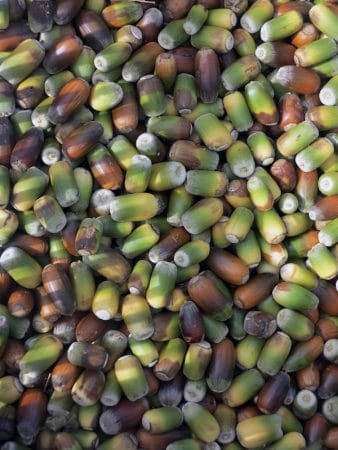 We met Mayer at the little farm store to begin a tour of her operations, starting first with the kitchen behind the store. Here is where she stores big vats of the cookie dough, which is rolled out in long cylinders, cut, then shaped and baked in batches of about 500 a day.
We met Mayer at the little farm store to begin a tour of her operations, starting first with the kitchen behind the store. Here is where she stores big vats of the cookie dough, which is rolled out in long cylinders, cut, then shaped and baked in batches of about 500 a day.
These cookies have collected a number of distinctions, from a 2015 People’s Choice award for most innovative product at the Athens Gastronomy Festival to a Superior Taste award from the International Taste and Quality Institute in Belgium. And this year Mayer was selected for the innovation area of SIAL, the biggest food expo in the world and a very difficult event to get into.
Before we left the store, a young, posh Athenian couple came in full of enthusiasm for the cookies and the Red Tractor wine. She chatted with them in rapid-fire Greek and cheerfully announced that the cookies, already sold in many stores across the island and Greece, had just been taken up by the supermarket chain Sklavenitis.
Next, Mayer took us for a walk around her farm and outlined the process from beginning to end of shelling, leaching and pressing the acorns. We had already seen many of the woods across the tiered slopes of the central and lower parts of the island, but she took us to inspect a tree up close. The acorns of the particular oak tree variety native to Kea, the Quercus ithaburensis subspecies macrolepis, are quite large: the scarcity of water on the island means that most of the trees’ energy actually goes into producing the nut. Mayer showed us how to tell if an acorn is getting ripe: it starts to grow out of its cap. In late August there were many that were already quite close to being ready.
The production of acorn flour all begins with the annual harvest, which runs from mid-September through mid-November. In a process that is not unlike making olive oil, first the trees are netted and whacked. The fallen fruit is sorted from the leaves and branches and left to dry. After the acorns have popped out from the caps, they are thoroughly aired on a 20-meter-long solar-powered dehydrator.
A telltale sign that the acorns are dry enough is that they begin to rattle in their shells. At this stage, Mayer explained, they can be put into storage and, in theory, last decades because the tannins in them act as a natural preservative. In this way, Mayer can draw on the acorns throughout the year in order to make her acorn flour.
If not being stored, the nuts are then hulled from their shells using a big blue hulling machine that Mayer imported from Turkey, where the same species of Valonia oak tree grows. Freed from their shells, the acorns next get put into large vats and soaked in water, sometimes repeatedly. This leaching process draws out the tannic acid and lasts until the nuts become soft enough to be sliced or crumbled and milled into flour.
The freshly milled acorn flour is a beautiful tan color and goes into freezer lockers to keep it safe from mildew and vermin. Mayer also showed us vats of the sweet-smelling tannin-rich water left over from the leaching process, which she is currently experimenting with together with scientists from the University of Athens, and has huge potential for use in developing skin care and cosmetic products.
The modest acorn, this most postmodern of foods, is making a mighty comeback.
Mayer has plans underway to build a much larger kitchen so she can accommodate an expanded repertoire of food items. She is also working on a cookbook that is due to come out in early 2019 with 50 plus different recipes that incorporate acorns. Yet at the moment, the acorn cookies are her little ambassadors, as Mayer likes to say, going out into the world and showing through their deliciousness the great potential of acorn-made food products, particularly since acorns grow virtually everywhere in the world, are rich in fiber, potassium, and other nutrients, and offer great food security because of how long they can be stored.
But on the little island of Kea, there were two challenges Mayer had to overcome first before she could begin experimenting with acorns in gastronomy.
The first was a very practical one: In 1997, when Mayer first started visiting, oak trees were being felled for fuel, denuding the landscape. That year had been a good one for the oak trees and acorns were everywhere, on the streets and paths. “You couldn’t miss them,” she said.
The abundance of acorns brought her back to her childhood in California, where she had grown up under two giant oak trees, and in school had learned about how Native Americans’ had widely used acorns for food. She even tried some experiments cooking with acorn flour as a kid, though not very successfully.
When Mayer moved to Kea permanently in 2004, after over a decade of owning her own restaurants and interior design company in Athens, she set out to stop the cutting down of all the island’s trees.
The solution to this problem came not through a radical new idea, but by working with local families and farmers to revitalize an old one. From at least as early as the 1500s until 1965, the oak trees on Tzia, the locals’ name for Kea island, had been a central part of the island’s economy. Farmers would sell the caps of the acorns, prized for their tannins that are used in the process of vegetable leather tanning, to tanneries on the mainland. According to Mayer, acorn caps are the “gold standard” in vegetable leather tanning. Not only do they not pollute the environment but they make for a more durable resilient leather, one that can keep gold lettering, for example.
Unfortunately, in 1965, this all changed. Tanneries began using a chemical compound in the leather tanning process that year, leaving tons upon tons of harvested acorn caps languishing at the port. Practically overnight this chemical replaced the traditional, more ecological, and higher-quality method.
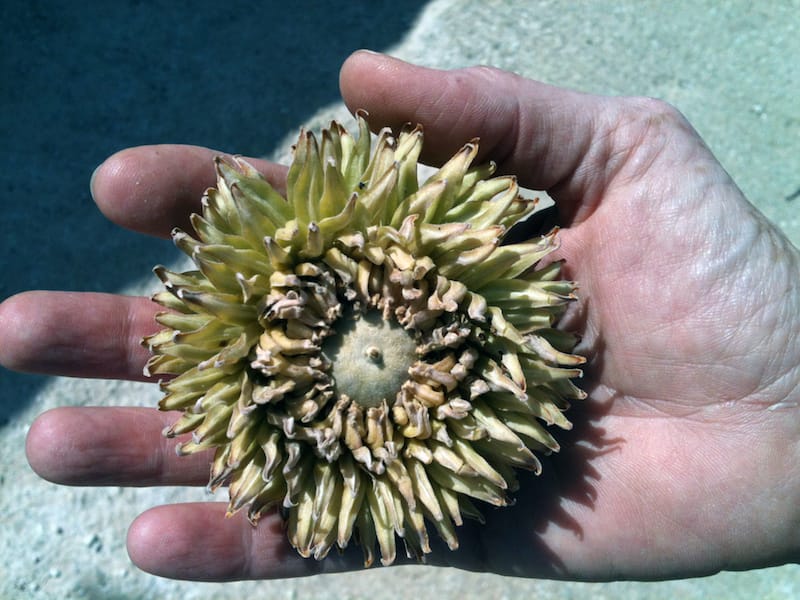
But after a lot of hard work and research and a little bit of serendipity, new buyers were found in Europe – an artisanal German tannery – and in the fall of 2011, the first shipment of acorn caps was sent out from Kea island after a nearly 50-year hiatus. Since then about 100,000 Kean acorn caps have been exported, giving farmers a much-needed incentive to keep their trees and a reliable, sustainable source of income. A much larger standing order is currently being negotiated with a family business in Izmir that makes the vegetable tanning substance.
Mayer was then free to come back to her experiments as a kid and begin again exploring uses for acorns in gastronomy, turning the flour into different edible goodies that grew into the Oakmeal acorn initiative and food company.
However, she also faced a less tangible obstacle – the stigma attached to eating acorns. When Mayer first starting trying to spread the idea of using acorns in cuisine, several islanders approached her privately. They admitted almost with shame that they had eaten acorns during Second World War and in the Civil War that followed when there were widespread food shortages. For them it was not something to speak openly about, the stigma stemming mainly from the fact that this is the food they feed their pigs. So her work in part has been changing perceptions.
Now in its seventh year, Oakmeal has made a lot of progress. Farmers have realized the value of their trees and in these hard times of economic crisis are happy for a little extra income. Chefs are answering the call, like Nicholas Tsakaloyiannis, who offers a mesclun and pickled acorn salad at Kylix, his restaurant in Ioulida, the island’s capital. Every fall on the island there is an annual Acorn Festival which takes place in Kato Meria and offers a selection of acorn foods along with tsipoura, as well as music, crafts and the annual acorn-weighing contest.
Every year for the harvest, Mayer employs volunteers from around the world, choosing from hundreds of applications. These mostly young people are housed in the Red Tractor Farm’s guesthouses for free and are treated to meals cooked by a chef for the week but are expected to work hard. Like the cookies, Mayer sees these volunteers as ambassadors that will go out in the world and share their knowledge, telling about how the modest acorn, this most postmodern of foods, is making a mighty comeback.
Bags that Mayer had specially made for transportation of the acorn caps have the word Hamada written on them, which in Greek refers to the fruit left behind to rot, what nobody wants. This was always the word that locals used to refer to acorn caps and in itself seems to raise the story of the Tzian acorn to the level of poetry. For the history of the acorn on Kea reads like a fable: so many years overlooked, undervalued, and neglected, the humble acorn, this once lowly “squirrel food,” is now starting to be appreciated in a new way, transformed into products that are ecological, tasty, and nutritious.
 August 22, 2016 CB on the Road
August 22, 2016 CB on the Road
As one approaches the port of Ermoupolis (named after Hermes, the god of commerce), the […] Posted in Athens June 29, 2016 CB on the Road
June 29, 2016 CB on the Road
Thessaloniki, the capital of Greek Macedonia and the country’s second largest metropolis […] Posted in Athens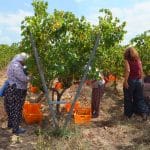 October 5, 2019 Wine Harvest Week
October 5, 2019 Wine Harvest Week
Zeynep Arca Şallıel had a successful career in advertising in Istanbul, but in 1995 she […] Posted in Istanbul
Zamira SkalkottasCourtesy of Marcie Mayer
Published on September 27, 2018
Related stories
August 22, 2016
AthensAs one approaches the port of Ermoupolis (named after Hermes, the god of commerce), the main town of the island of Syros and capital of the Cyclades, one cannot help but marvel at its beauty and grandeur. Imposing public buildings and private mansions, marble-paved streets, a large Italian-style piazza and numerous churches make the city…
June 29, 2016
AthensThessaloniki, the capital of Greek Macedonia and the country’s second largest metropolis after Athens, 500 km to the south, is a youth-loving, vibrant city that never sleeps – and always eats. Most locals here are friendly, laid-back, natural-born foodies who love going out and enjoying good wine and tsipouro. It’s a city with a very…
October 5, 2019
IstanbulZeynep Arca Şallıel had a successful career in advertising in Istanbul, but in 1995 she decided to take on a daunting new challenge: taking part in the revival of small-scale viniculture in the ancient winemaking region of Thrace.“I wanted to do something with soil, something that mattered a little bit more,” she says. Her father…







































